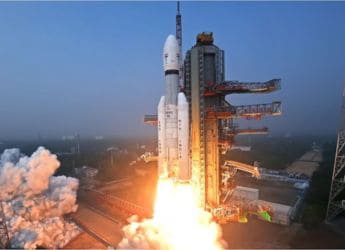- Home
- Science
- Science News
- NASA’s Juno Mission Shares Stunning Images of Jupiter and Its Moon Ganymede
NASA’s Juno Mission Shares Stunning Images of Jupiter and Its Moon Ganymede
Telescopes on Earth’s surface couldn’t have taken a similar backlit image of Jupiter, say NASA scientists

This backlit view of the crescent Jupiter from Juno was taken by using raw data from the JunoCam
NASA's Juno mission has yet again stunned us with breath-taking images of Jupiter and its moon, Ganymede. Scientists are awed by an image of Jupiter in a crescent phase. The picture was taken when NASA's Juno spacecraft approached the giant planet during a regular close pass. The crescent shape of Jupiter can never be captured from telescopes on Earth's surface. The blog post explained why this was so. It stated that this image of Jupiter in a crescent phase, unlike the Moon or Venus, was difficult to observe from Earth, even with the aid of a telescope.
The post went on to add that Jupiter's orbit was outside the Earth's, hence an observer on Earth can only view the side of Jupiter that is illuminated by the Sun. So, the planet appears to be full at all times.
This backlit view of the crescent Jupiter from Juno was taken by using raw data from the JunoCam instrument. Citizen scientist Kevin M. Gill created the image from seven images that were taken during Juno's 39th close pass by Jupiter on January 12, 2022. The website stated, “If you could ride along with NASA's Juno spacecraft as it approaches Jupiter during one of its regular close passes by the giant planet, you would be treated to a striking vista similar to this one.”
Another image shared on NASA's website was that of the complex surface of Jupiter's moon Ganymede. Ganymede, the largest moon in our solar system, is known for its own magnetic field.
A Space.com report states that the Ganymede image was captured in June 2021 during a close pass. Juno flew only 650 miles (1,046 kilometres) above Ganymede's surface when it shot this photo. The enhanced-color image was created by citizen scientist Thomas Thomopoulos.
The image is of the large crater Kittu. The crater is almost 9 miles (15 kilometres) across and is surrounded by darker material. Scientists believe the material got ejected when a small asteroid crashed into the moon's surface.
The NASA website further stated that most of Ganymede's craters had brilliant rays extending from the impact scar, whereas just around 1 percent contained dark rays.
Ganymede is the largest moon in the solar system. It's even bigger than the planet Mercury.
Get your daily dose of tech news, reviews, and insights, in under 80 characters on Gadgets 360 Turbo. Connect with fellow tech lovers on our Forum. Follow us on X, Facebook, WhatsApp, Threads and Google News for instant updates. Catch all the action on our YouTube channel.
Related Stories
- Samsung Galaxy Unpacked 2025
- ChatGPT
- Redmi Note 14 Pro+
- iPhone 16
- Apple Vision Pro
- Oneplus 12
- OnePlus Nord CE 3 Lite 5G
- iPhone 13
- Xiaomi 14 Pro
- Oppo Find N3
- Tecno Spark Go (2023)
- Realme V30
- Best Phones Under 25000
- Samsung Galaxy S24 Series
- Cryptocurrency
- iQoo 12
- Samsung Galaxy S24 Ultra
- Giottus
- Samsung Galaxy Z Flip 5
- Apple 'Scary Fast'
- Housefull 5
- GoPro Hero 12 Black Review
- Invincible Season 2
- JioGlass
- HD Ready TV
- Laptop Under 50000
- Smartwatch Under 10000
- Latest Mobile Phones
- Compare Phones
- Honor Win RT
- Honor Win
- Xiaomi 17 Ultra Leica Edition
- Xiaomi 17 Ultra
- Huawei Nova 15
- Huawei Nova 15 Pro
- Huawei Nova 15 Ultra
- OnePlus 15R
- Asus ProArt P16
- MacBook Pro 14-inch (M5, 2025)
- OPPO Pad Air 5
- Huawei MatePad 11.5 (2026)
- Xiaomi Watch 5
- Huawei Watch 10th Anniversary Edition
- Acerpure Nitro Z Series 100-inch QLED TV
- Samsung 43 Inch LED Ultra HD (4K) Smart TV (UA43UE81AFULXL)
- Asus ROG Ally
- Nintendo Switch Lite
- Haier 1.6 Ton 5 Star Inverter Split AC (HSU19G-MZAID5BN-INV)
- Haier 1.6 Ton 5 Star Inverter Split AC (HSU19G-MZAIM5BN-INV)

















